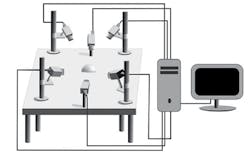Fruit flies tracked by vision
Using multiple synchronized and calibrated cameras, researchers in the UK and the US have built a vision system that enables them to detect and keep track of the behavior of fruit flies.
The system they constructed to do so is composed of four calibrated and synchronized Point Grey (Richmond, BC, Canada) Grasshopper digital cameras mounted on a camera rig, each fitted with an Edmund Optics (Barrington, NJ, USA) 88mm fixed focal lens. For some experiments, two more cameras were added to the set up.
The cameras were connected with FW800 PCI-E cards to a PC with two 2.8 GHz Intel 64-bit quad core Xeon processors with 8GB of RAM.
The software for the tracking system -- including acquisition of images from the cameras, silhouette detection and extraction of two-dimensional measurements, 3-D reconstruction and tracking algorithms -- was implemented in Microsoft Visual C++ 2005 using the Point Grey SDK and OpenCV libraries. Trajectory analysis and automated behavior recognition were implemented in Matlab using Statistics Toolbox v. 7.5.
The system itself has enabled the researchers to track of multiple flies in a three-dimensional space for a long period of time. They believe that it opens the door to many animal behavior studies that were not previously feasible.
The researchers -- from the University of Southern California (Los Angeles, CA, USA) the University of Cambridge (Cambridge, UK), Florida State University (Tallahassee, FL, USA) and University of California at Davis, (Davis, CA, USA) -- recently detailed the design of the system in a technical paper.
Entitled “Three-dimensional tracking and behavior monitoring of multiple fruit flies," the paper was published in the Journal of The Royal Society. It can be downloaded here.
Related articles from Vision Systems Design you might also be interested in.
1. LED design inspired by fireflies
The nighttime twinkling of fireflies has inspired scientists to modify a light-emitting diode (LED) so it is more than one and a half times as efficient as the original.
2. UK researchers to model vision and smell of bees
Sussex University (Brighton, UK) scientists are working with partners at the Sheffield University (Sheffield, UK) to produce the first accurate computer models of a honey bee brain in a bid to advance their understanding of Artificial Intelligence.
3. Imaging insects using robots
Researchers at the SR2 Group (Laurel, MD, USA) have been awarded a Small Business Innovation Research (SBIR) grant from the National Science Foundation to enable them to develop a robotic system to automate the capture of 3-D images of insects.
4. Coating copies the eye of a moth
A group at the Max Planck Institute for Intelligent Systems (Stuttgart, Germany) co-ordinated by Professor Joachim Spatz has developed a new way to artificially produce moth eye-like coatings.
-- Dave Wilson, Senior Editor, Vision Systems Design
